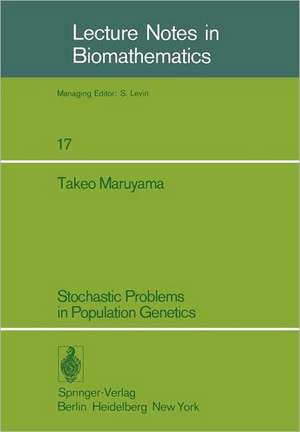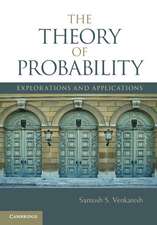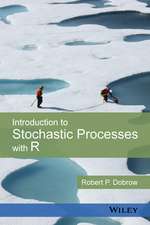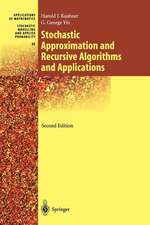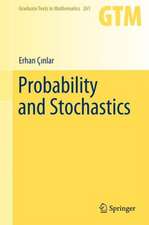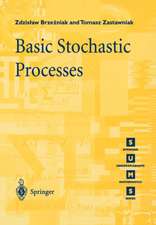Stochastic Problems in Population Genetics: Lecture Notes in Biomathematics, cartea 17
Autor T. Maruyamaen Limba Engleză Paperback – aug 1977
Din seria Lecture Notes in Biomathematics
-
 Preț: 378.54 lei
Preț: 378.54 lei -
 Preț: 380.45 lei
Preț: 380.45 lei -
 Preț: 413.37 lei
Preț: 413.37 lei -
 Preț: 390.63 lei
Preț: 390.63 lei -
 Preț: 396.24 lei
Preț: 396.24 lei -
 Preț: 387.38 lei
Preț: 387.38 lei -
 Preț: 385.08 lei
Preț: 385.08 lei - 5%
 Preț: 366.56 lei
Preț: 366.56 lei -
 Preț: 384.70 lei
Preț: 384.70 lei -
 Preț: 394.29 lei
Preț: 394.29 lei - 5%
 Preț: 389.93 lei
Preț: 389.93 lei - 5%
 Preț: 370.74 lei
Preț: 370.74 lei -
 Preț: 384.86 lei
Preț: 384.86 lei -
 Preț: 387.96 lei
Preț: 387.96 lei -
 Preț: 404.29 lei
Preț: 404.29 lei -
 Preț: 391.61 lei
Preț: 391.61 lei -
 Preț: 384.48 lei
Preț: 384.48 lei -
 Preț: 384.48 lei
Preț: 384.48 lei -
 Preț: 383.71 lei
Preț: 383.71 lei -
 Preț: 379.68 lei
Preț: 379.68 lei -
 Preț: 384.09 lei
Preț: 384.09 lei -
 Preț: 405.66 lei
Preț: 405.66 lei -
 Preț: 379.48 lei
Preț: 379.48 lei -
 Preț: 400.65 lei
Preț: 400.65 lei -
 Preț: 385.25 lei
Preț: 385.25 lei -
 Preț: 390.25 lei
Preț: 390.25 lei -
 Preț: 395.47 lei
Preț: 395.47 lei -
 Preț: 378.71 lei
Preț: 378.71 lei -
 Preț: 382.95 lei
Preț: 382.95 lei - 15%
 Preț: 578.01 lei
Preț: 578.01 lei -
 Preț: 380.84 lei
Preț: 380.84 lei -
 Preț: 405.66 lei
Preț: 405.66 lei -
 Preț: 399.12 lei
Preț: 399.12 lei -
 Preț: 410.66 lei
Preț: 410.66 lei -
 Preț: 385.62 lei
Preț: 385.62 lei - 5%
 Preț: 371.10 lei
Preț: 371.10 lei -
 Preț: 378.71 lei
Preț: 378.71 lei -
 Preț: 386.99 lei
Preț: 386.99 lei -
 Preț: 401.61 lei
Preț: 401.61 lei -
 Preț: 350.30 lei
Preț: 350.30 lei -
 Preț: 383.33 lei
Preț: 383.33 lei -
 Preț: 408.54 lei
Preț: 408.54 lei -
 Preț: 398.53 lei
Preț: 398.53 lei -
 Preț: 399.67 lei
Preț: 399.67 lei -
 Preț: 391.79 lei
Preț: 391.79 lei -
 Preț: 384.86 lei
Preț: 384.86 lei -
 Preț: 401.61 lei
Preț: 401.61 lei -
 Preț: 392.60 lei
Preț: 392.60 lei -
 Preț: 406.05 lei
Preț: 406.05 lei
Preț: 388.13 lei
Nou
Puncte Express: 582
Preț estimativ în valută:
74.27€ • 76.62$ • 61.98£
74.27€ • 76.62$ • 61.98£
Carte tipărită la comandă
Livrare economică 27 martie-10 aprilie
Preluare comenzi: 021 569.72.76
Specificații
ISBN-13: 9783540083498
ISBN-10: 3540083499
Pagini: 260
Ilustrații: VIII, 248 p.
Dimensiuni: 170 x 244 x 14 mm
Greutate: 0.42 kg
Ediția:Softcover reprint of the original 1st ed. 1977
Editura: Springer Berlin, Heidelberg
Colecția Springer
Seria Lecture Notes in Biomathematics
Locul publicării:Berlin, Heidelberg, Germany
ISBN-10: 3540083499
Pagini: 260
Ilustrații: VIII, 248 p.
Dimensiuni: 170 x 244 x 14 mm
Greutate: 0.42 kg
Ediția:Softcover reprint of the original 1st ed. 1977
Editura: Springer Berlin, Heidelberg
Colecția Springer
Seria Lecture Notes in Biomathematics
Locul publicării:Berlin, Heidelberg, Germany
Public țintă
ResearchCuprins
1 Orientation.- 1.1 Discrete space, continuous time, random walk.- 1.2 Discrete space, discrete time.- 1.3 Circular space, continuous time.- 1.4 Continuous space, continuous time.- 1.5 Markov process.- 1.6 Dynkin’s formula.- 2 Population Genetics Models.- 2.1 Wright’s model.- 2.2 Feller’s model.- 2.3 Moran’s model.- 2.4 Variable population size.- 2.5 Wright’s model with mutation.- 2.6 A model of irreversible mutation or a model of infinite alleles.- 2.7 A selection model.- 2.8 A model of dominance.- 2.9 Birth-and-death process.- 2.10 Density or frequency dependent process.- 2.11 Time inhomogeneous process.- 2.12 A model of random environment.- 3 Classification of Boundaries.- 3.1 Regular boundary.- 3.2 Exit boundary.- 3.3 Entrance boundary.- 3.4 Natural boundary.- 3.5 Nature of boundary.- 3.6 Examples.- 4 Expectation of Integration Along Sample Paths.- 4.1 Integration along sample paths.- 4.2 The boundary conditions.- 4.3 An example.- 4.4 Green’s function for a pure random process.- 4.5 Computer simulation.- 4.6 Sum of heterozygotes.- 4.7 Process with reflecting boundary.- 4.8 Irreversible mutation model (or infinite alleles).- 4.9 General form of Green’s function.- 4.10 Probability of fixation.- 4.11 Behavior of sample paths near the origin.- 4.12 Higher moments.- 4.13 Nagylaki’s formula.- 5 Modification of Processes.- 5.1 Killing and creating paths.- 5.2 Selection of paths.- 5.3 Random drift and fixation time.- 5.4 A case of genic selection.- 5.5 A symmetric property of sample paths.- 5.6 A general formula.- 5.7 Age of sample paths.- 5.8 Number of affected individuals and genetic load.- 5.9 Sojourn time of conditional sample paths on the present-frequency.- 5.10 A conditional age.- 5.11 Computer simulation.- 5.12 Random time change.- 6 NumericalIntegration of the Kolmogorov Backward Equation.- 6.1 Integration method.- 6.2 Examples.- 7 Eigenvalues and Eigenvectors of the KBE.- 7.1 Eigenvalues and eigenvectors.- 7.2 Pure random drift case.- 7.3 Mutation and random drift case.- 7.4 Irreversible mutation case.- 7.5 Hypergeometric differential equation.- 7.6 Orthogonality of eigenfunctions.- 7.7 Expansion by eigenfunctions.- 7.8 The steady-state distribution of gene frequencies.- 8 Approximation Methods.- 8.1 Perturbation.- 8.2 Examples.- 8.3 Numerical method.- 8.4 Singular perturbation.- 9 Geographical Structure of Populations.- 9.1 One-dimensional populations, discrete colonies.- 9.2 Continuous space.- 9.3 Two-dimensional populations.- 9.4 Two-dimensional continuous space.- 9.5 Higher order moments.- 9.6 Numerical analysis at equilibrium.- 9.7 A differential equation and asymptotic formulae.- 9.8 Random drift.- 9.9 Time to fixation.- 10 Geographically Invariant Properties.- 10.1 Discrete time model.- 10.2 Continuous time model.- 10.3 Markov process.- 10.4 Diffusion method.- 10.5 Computer simulation of gene frequency change.- 10.6 Invariance based on diffusion method.- 10.7 Computer simulation of heterozygote distribution and other invariant properties.- 11 Gene Frequency Distributions and Random Drift in Geographically Structured Populations.- 11.1 Gene frequency distribution (global) in a structured population.- 11.2 Distribution of local gene frequencies.- 11.3 Random drift in a structured population.- 12 Some Special Problems.- 12.1 Variance of homozygote probability for the infinite neutral allele model.- 12.2 Variance of homozygote probability in a geographically structured population.- 12.3 Number of alleles.- 12.4 Some properties of the stepwise mutation model.- A1.1 Mutation model I.- A1.2 Mutation modelII.- A1.3 Derivation of Kolmogorov backward equations (KBE).- Appendix II A Supplementary Note on the Existence and Uniqueness of the Solution for the Recurrence Equation (9.7).- Appendix III Distribution of Stochastic Integrals.- References.
